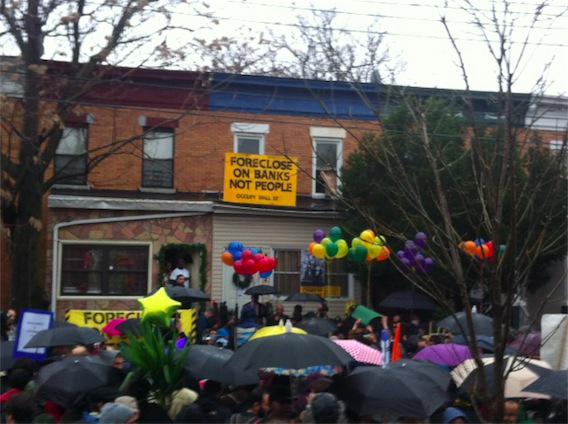Mike Konczal’s wonky take on the “Occupy Homes” anti-foreclosure offshoot of the Occupy movement reminds me of the first thing I ever wrote about the Great Recession, back before I really understood that’s what I was writing about. I was on staff at The Atlantic in late 2007, and was headed to Miami for separate reasons and an editor there suggested that it would be good to get a piece reported from there on mass foreclosure neighborhoods. I cited a study noting that “every foreclosure reduces the value of all other houses within an eighth of a mile by about 1 percent, as the sight of vacant property scares off potential buyers.” At the time, however, we weren’t anticipating the kind of prolonged vacancies Konczal talks about here:
I don’t think we’ve heard enough from the neighbors of the abandoned homes that were reclaimed in these events. I talked with one of the neighbors of the house that was reclaimed in East New York as it was happening, and he told me that the house had sat vacant for a few years. Contractors doing nearby demolition work would come in the middle of the night and dump bags of garbage on the house’s front lawn because they knew it was empty. There would be broken sinks, glass, bricks and other garbage that couldn’t sit there, since there were many kids in the area. So the neighbors would have to get together and haul off the materials.
He also brought up that he’d have to shovel the snow in front of the place during the winter, since there were many older folks in the community as well, and the banks weren’t going to keep the sidewalks clear. He expressed concern that someone with a chemical dependency could set up shop in the house. As the neighbor put it, “what if at 1 or 2 in the morning the person’s drugs run out? They step outside, and maybe an older person is walking by themselves down the street. That could escalate into a bad situation.” Or maybe a fire started, which spread to the roofs of the other connected row houses? The Occupy crew that went in to clean the place found extensive black mold – the banks left the place to rot.
These kind of scenarios are of course familiar to those of us who’ve lived for years in urban neighborhoods spotted with vacant homes. Sometimes there’s nothing you can do about this. But it’s tragic and absurd to turn a home from inhabited to vacant against the wishes of its occupants. If a family loses a home and then the home gets sold to someone new, that’s a household-level tragedy. But if a family loses a home and then the home stands empty to rot, that’s a waste and a neighborhood tragedy. Having it happen all across the country is a disaster.
